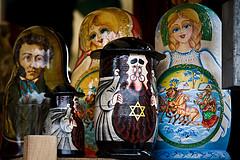 Titles pictures speak for themselves: 'Beggars in Samarkand "(1870),' Opiumoedy ',' Sale of child slaves' (1872), 'dungeon Samarkand', 'The Uzbek woman in Tashkent' (1873) and many others. The artist has a brush easily and has an amazing memory, which allows him to return to previously seen events and transfer them to canvas. The main theme of the artist chooses a military event. His heroes are ordinary Russian soldiers in the pictures shows a brave harsh, the truth of war. A number of works he combines in series: the painting "In the fortress wall. Let the will '(1871) severely and firmly expect to fight Russian soldiers.
Titles pictures speak for themselves: 'Beggars in Samarkand "(1870),' Opiumoedy ',' Sale of child slaves' (1872), 'dungeon Samarkand', 'The Uzbek woman in Tashkent' (1873) and many others. The artist has a brush easily and has an amazing memory, which allows him to return to previously seen events and transfer them to canvas. The main theme of the artist chooses a military event. His heroes are ordinary Russian soldiers in the pictures shows a brave harsh, the truth of war. A number of works he combines in series: the painting "In the fortress wall. Let the will '(1871) severely and firmly expect to fight Russian soldiers.
Painting 'entered' reflects the same place, but after the fight. In paintings' Look out '(1873), "Surprise Attack" (1871),' Present trophies' (1872), 'triumph' (1872) and 'The Apotheosis of War (1871-1872). Vereshchagin exposes the cruelty of feudal lords, lords savage manners and praises the courage of simple Russian soldiers. Passionate prosecution of war to become his painting 'The Apotheosis of War, in which the background of debris left over from the city and burned trees, stands the pyramid of human skulls. The idea arose from the warrior Tamerlane, who after leaving his victories are the pyramids. But the skull fracture and become a symbol of all wars, and the artist paints on a frame: "Dedicated to all the great conquerors – past, present and future." Such a bold and accusatory criticism is hostility to the reactionary circles of Russia. He is accused of being hostile to the host.
Painter hurt unfair accusations. Yielding to the senses, he burns the painting 'The Forgotten', 'surrounded – persecuted' and 'They went'. The tsarist government did not consider it necessary to acquire paintings Vereshchagin, he forbid to organize exhibitions, the press is not allowed to reproduce his paintings on their pages. Only Pavel Tretyakov bought a large part of the Turkestan works.